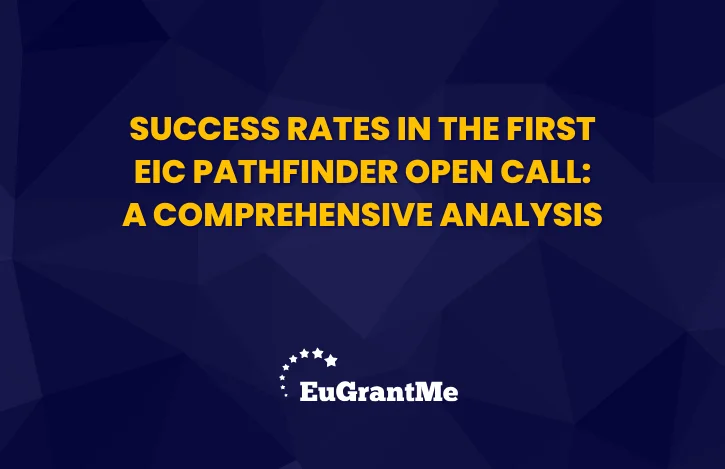The success rates in the first EIC Pathfinder Open Call are a topic of significant interest for innovators and researchers seeking funding and support for their ground-breaking projects. In this article, we will delve into the success rates of the inaugural EIC Pathfinder Open Call, analysing key trends, factors influencing success, and implications for future applicants.
Understanding Success Rates in the EIC Pathfinder Open Call
The success rates in the first EIC Pathfinder Open Call provide valuable insights into the competitiveness and dynamics of the funding landscape for transformative innovation projects. As the European Innovation Council (EIC) seeks to identify and support high-potential projects with the capacity to deliver disruptive innovations and address societal challenges, understanding the success rates is crucial for prospective applicants seeking to optimise their chances of securing funding.
Key Factors Influencing Success
Several factors influence the success rates in the EIC Pathfinder Open Call, including:
1. Quality of Proposals
The quality and novelty of project proposals play a significant role in determining success rates. Projects with innovative concepts, clear objectives, and strong potential for impact are more likely to receive funding.
2. Alignment with EIC Priorities
Projects that align closely with the strategic priorities and focus areas of the EIC are more likely to be successful. Applicants should ensure that their proposals address pressing societal challenges and contribute to the objectives of Horizon Europe.
3. Interdisciplinary Collaboration
The EIC encourages interdisciplinary collaboration and diversity in project consortia. Proposals that bring together expertise from multiple disciplines and sectors are better positioned to address complex challenges and deliver holistic solutions.
4. Feasibility and Scalability
The feasibility and scalability of project concepts are crucial considerations for evaluators. Projects that demonstrate a clear pathway to implementation, commercialisation, and societal impact are more likely to succeed.
Analysis of Success Rates
An analysis of the success rates in the first EIC Pathfinder Open Call reveals several notable trends and patterns. While the overall success rates may vary depending on factors such as the specific topic, budget availability, and evaluation criteria, certain common themes emerge across successful proposals.
1. Innovative and Disruptive Solutions
Successful projects often propose innovative and disruptive solutions to pressing societal challenges, leveraging cutting-edge technologies, methodologies, and approaches.
2. Strong Consortium and Partnerships
Projects with strong consortiums comprising diverse stakeholders, including academia, industry, research organisations, and end-users, tend to have higher success rates. Effective collaboration and partnership-building are critical success factors.
3. Clear Impact Pathway
Successful proposals articulate a clear impact pathway, outlining how project outcomes will contribute to societal, economic, or environmental benefits. They demonstrate a thorough understanding of the market, regulatory landscape, and end-user needs.
4. Robust Implementation Plan
Successful projects present a robust implementation plan, including detailed work packages, milestones, and deliverables. They demonstrate a realistic timeline, budget allocation, and risk management strategy.
Implications for Future Applicants
The analysis of success rates in the first EIC Pathfinder Open Call offers valuable insights and lessons for future applicants. Prospective applicants can leverage these insights to strengthen their proposals and increase their chances of success in subsequent calls. Key implications include:
1. Focus on Innovation and Impact
Applicants should focus on developing innovative and impactful project concepts that address significant societal challenges and have the potential to deliver transformative solutions.
2. Build Strong Partnerships
Collaboration and partnership-building are key to success in Horizon Europe projects. Applicants should proactively seek out complementary partners and stakeholders to enhance the quality and impact of their proposals.
3. Address Evaluation Criteria
Applicants should carefully review the evaluation criteria and guidelines provided in the call documents and ensure that their proposals address all relevant criteria comprehensively.
4. Seek Feedback and Review
Before submitting their proposals, applicants should seek feedback from peers, mentors, or experts in the field to identify areas for improvement and refinement. Peer review and constructive feedback can help strengthen proposals and increase their competitiveness.
Conclusion: Key Takeaways and Recommendations
In conclusion, the success rates in the first EIC Pathfinder Open Call provide valuable insights into the factors influencing funding decisions and the characteristics of successful proposals. By analysing these success rates and understanding the underlying trends, prospective applicants can enhance their competitiveness and maximise their chances of success in future calls. As the EIC continues to support ground-breaking innovation projects through its Pathfinder programme, aspiring innovators and researchers are encouraged to leverage these insights and recommendations to unlock new opportunities for impactful research and innovation in Europe and beyond.
At EuGrantMe, we are passionate about fostering innovation and empowering ambitious minds to flourish. Our mission revolves around providing top-notch grant writing services for the EIC Accelerator and Horizon grants in Europe, enabling our customers to unlock the full potential of their ground-breaking ideas.
Do you have a project to turn into reality?
Contact us!


